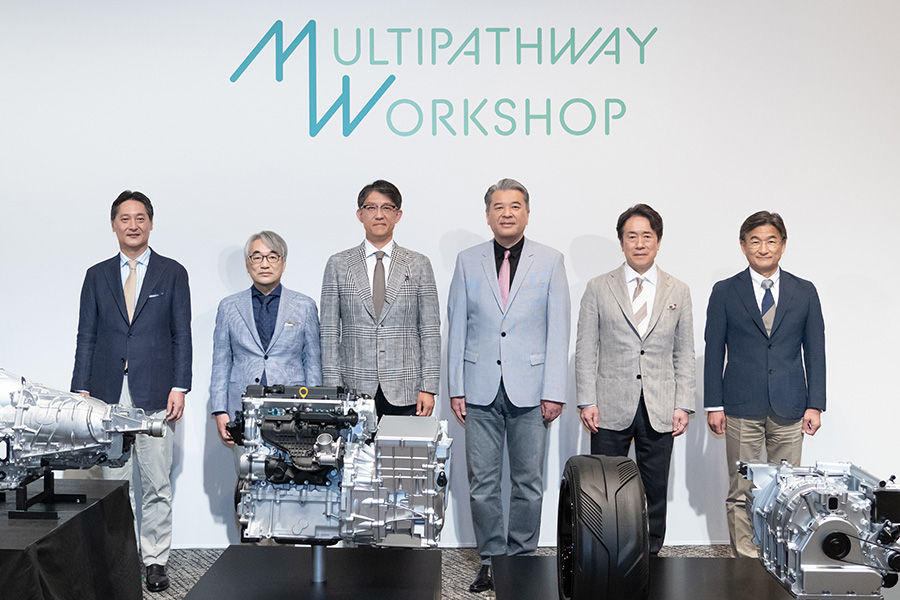Subaru Corporation (Subaru), Toyota Motor Corporation (Toyota), and Mazda Motor Corporation (Mazda) have each committed to developing new engines tailored to electrification and the pursuit of carbon neutrality. With these engines, each of the three companies will aim to optimize integration with motors, batteries, and other electric drive units. While transforming vehicle packaging with more compact engines, these efforts will also decarbonize ICEs by making them compatible with various carbon-neutral (CN) fuels(1).

Subaru, Toyota, and Mazda have always been driven by a deep understanding of their customers’ diverse lifestyles. This understanding has led the three companies to develop signature engines(2) that not only represent their respective brands but also cater to their customers’ unique needs and preferences.
In pursuing decarbonization, all three companies have focused on carbon as the enemy and sought to expand options by acting with passion and purpose. This mindset has driven efforts to ensure a future for the supply chains and jobs that underpin engines. Under the extreme conditions of racing, the companies have worked to broaden powertrain and fuel options by competing with vehicles running on liquid hydrogen and CN fuels.
This process has clarified the role that future engines will play in achieving carbon neutrality. With the next generation of engines, the three companies will seek to not only improve standalone engine performance but also optimize their integration with electric drive units, harnessing the advantages of each.
While being highly efficient and powerful, the new engines will also revolutionize vehicle packaging by being more compact than existing models. Smaller engines will allow for even lower hoods, improving design possibilities and aerodynamic performance while contributing to better fuel efficiency. The development will also emphasize compliance with increasingly strict emissions regulations.
At the same time, the new engines will be made carbon neutral by shifting away from fossil fuels and offering compatibility with various alternatives, including e-fuel (synthetic fuel), biofuels, and liquid hydrogen. In doing so, these engines will contribute to the broader adoption of CN fuels.
Upon this announcement, the CEOs of the three companies made the following comments:”Achieving a carbon-neutral society is a challenge that must be undertaken by all of Japan’s industries and society as a whole. As we continue to refine electrification technology, we will also enhance our horizontally-opposed engines with an aim to use carbon-neutral fuels in the future. Moving forward, the three companies sharing the same aspiration will continue to advance the pursuit of sustainable excellence in Japanese car manufacturing.”(Atsushi Osaki, Representative Director, President and CEO, Subaru Corporation)
“In order to provide our customers with diverse options to achieve carbon neutrality, it is necessary to take on the challenge of evolving engines that are in tune with the energy environment of the future. The three companies, which share the same aspirations, will refine engine technologies through friendly competition.”(Koji Sato, President, Member of the Board of Directors and CEO, Toyota Motor Corporation)
“We will continue to offer customers exciting cars by honing internal combustion engines for the electrification era and expanding the multi-pathway possibilities for achieving carbon neutrality. Given the rotary engine’s compatibility with electrification and carbon-neutral fuels, Mazda will continue to develop the technology through co-creation and competition to ensure it can contribute broadly to society.”(Masahiro Moro, Representative Director, President and CEO, Mazda Motor Corporation)
Even as Subaru, Toyota, and Mazda compete in the product arena with unique engines and cars, the companies have a shared dedication to achieving carbon neutrality through a multi-pathway approach. Together with like-minded partners similarly skilled and passionate about engines, they will work to create the future of Japan’s auto industry.
(1) Fuels with net zero CO2 emissions into the atmosphere across their lifecycle, from manufacture to use. These include e-fuel, made from hydrogen and carbon dioxide, and biofuels derived from biomass (plants, etc.).
(2) Each company’s iconic enginesSubaruHorizontally-opposed engine. Pistons move horizontally, resulting in a low-profile engine with less vibration & lower center of gravity.ToyotaInline-four engine. Achieves both high output and high thermal efficiency.MazdaRotary engine. Compact and lightweight, yet powerful. Currently used for generators.
Subaru website: www.subaru.co.jp/news-en/2024_05_28_112205
Mazda website: https://newsroom.mazda.com/en/publicity/release/2024/202405/240528a.html
Copyright ©2024 JCN Newswire. All rights reserved. A division of Japan Corporate News Network.



